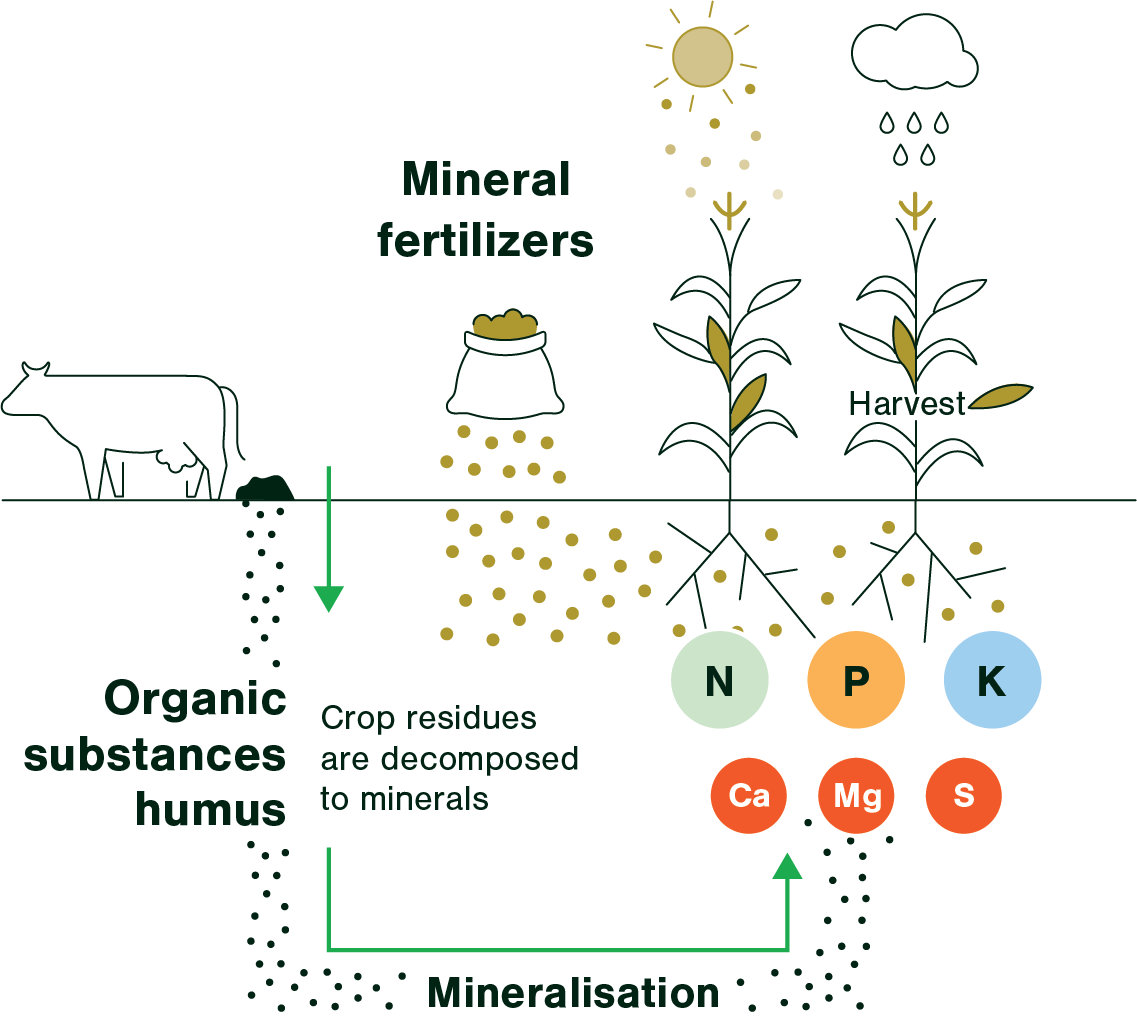What Is Agricultural Lime?
In order to
counter the high acidity of the soil, certain soil amendments can be added to
raise the pH levels and neutralize the acidic soil. Agricultural lime is the
most effective soil amendment for raising pH levels in order to improve crop
health and production.
Agricultural lime
is a soil amendment product used to condition soil by raising pH levels. It is
made from crushed limestone that contains natural nutrients to promote healthy
plant growth. When lime is added to agricultural crops, it dissolves and
releases a base that counteracts or neutralizes soil acidity.
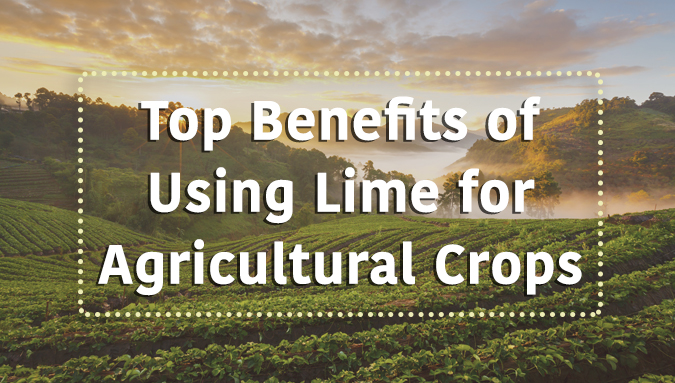
Types of Lime for Agricultural Crops
Depending on how
acidic the soil has become, there are different types of lime products to use.
Lime is available as magnesium or calcium additives. Magnesium-based lime is called dolomitic lime.
Calcium-based lime is called calcitic lime. Depending on your soil’s specific
deficiency, it may require one type of lime or the other. It may even require a
combination of both.
Agricultural lime
comes in several states: oxides, hydroxide, silicate or carbonate. These are
the forms of magnesium or calcium that will neutralize pH levels in the soil.
Calcium and magnesium on their own will not neutralize the pH level. Only when
they are applied in these forms will they serve the purpose of lowering acidity
levels.
Reducing Acidity Levels in Soil
Soil naturally
contains countless minerals and nutrients that each serve a purpose in helping
crops grow healthily. When the mineral content becomes unbalanced, the soil can
become too alkalized or too acidic depending on the levels of the different
types of minerals.
When the soil
contains high levels of minerals like iron, aluminum and manganese, then a pH
imbalance is created. This causes soil acidity levels to rise. Simultaneously,
this also causes a deficiency in other important soil minerals such as calcium
and magnesium. Without calcium and magnesium, plants cannot reach healthy
growth levels.
This pH imbalance can
happen for any number of reasons. The soil itself could be naturally higher in
these mineral contents, or it could be caused by the types of fertilizers being
used. Alternatively, soil can become acidic when the presence of beneficial
bacteria found in organic matter dwindles and there isn’t enough microbial
activity in the soil. Whatever the case may be, acidic soil is generally a
nutrient imbalance or deficiency that prevents healthy plant growth.
When soil becomes
too acidic, it makes it very difficult for plant roots to grow. In fact, acidic
soil can stunt root growth altogether, which prevents plant development. Plant
roots aren’t able to take up nutrients effectively, which lowers the overall
health level of the crops. In essence, high acidity creates a toxic environment
for crops.
How Lime Helps Crops Grow
Agricultural lime
helps lower the soil’s acidity levels by rendering it more pH neutral. By
applying lime to the soil when it becomes too acidic, farmers can ensure they
are helping improve their crop output. If crops can’t properly grow, they can’t
produce, which impacts the agriculture business and its bottom line. This is
why it becomes important to test your soil’s pH levels to determine the
appropriate remedy as
needed. Testing soil can help you determine where and when lime is needed, as
well as how much.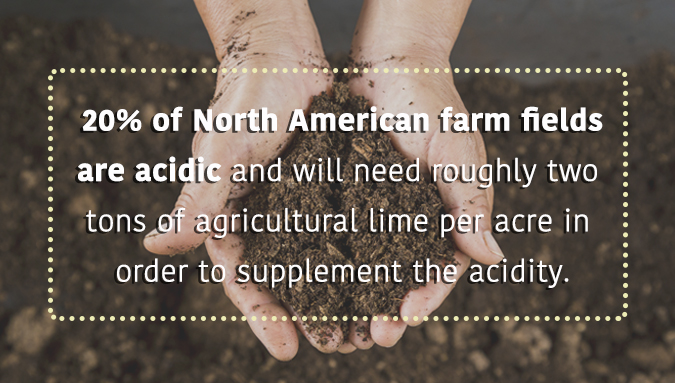

In order to remedy
the problem of acidic soil, lime can be applied to crops to raise the pH levels
by adding in calcium and magnesium. Lime acts as a natural acid neutralizer for
soil, which helps to reduce acidity and assist in returning the soil to a pH
neutral status.
When soil is
acidic, lime can help raise the pH levels, which improves many aspects of crop
health. Agricultural lime comes in several forms that can neutralize the
acidity in the soil. Lime is derived from magnesium or calcium carbonates,
oxides, hydroxides or silicates. These substances help to neutralize the
acidity in the soil and provide a thriving soil environment for crops to grow
properly.
How Crops React to Lime
Different types of
plants are more resistant to acidic soil than others. Certain types of plants
can withstand the toxicity of acidic soil, while others will be much more
susceptible and will not be able to withstand the toxicity. It’s important to
understand each crop’s specific acidic tolerance before applying a lime
solution.
When the right
type of agricultural lime is appropriately applied to acidic soil, the crops
that were once facing toxic conditions will begin to benefit from the change in
pH levels. Plant roots will benefit from the calcium and/or magnesium
supplementation. Roots will become more efficient at nutrient uptake. This will
strengthen the overall root system and plant structure over time.
Agricultural lime
products used on acidic soil have a natural varying size of particles. The
plant roots can immediately absorb the smaller particles, as they are tiny
enough for the roots to take up. The larger particles remain in the soil and
continue to neutralize the soil’s acidity. The larger particles slowly break
down over time into smaller particles. This helps to deliver a continuous
supply of calcium and/or magnesium to the crops over a typical two to five-year
period.
These improvements
then go on to increase the crop’s ability to produce, which leads to greater
yields and thus more profit for the farmer. Crops such as small grains, corn,
Bermuda grass, soybeans and other legumes can greatly benefit from agricultural
lime to improve yields.
Applying Lime to Agricultural Crops
Once the soil has
been tested throughout the field, you can then determine the appropriate amount
of lime to use. Certain sections of the soil may be more acidic than others. In
this case, a suitable lime application plan must be created in order to avoid
over- or undersupplying lime across the field.
Certain crop
species may also have different lime amount requirements. Some crops may need
only a slight decrease in acidity, whereas some would benefit from a much
greater effort in balancing pH levels.
In many cases
agricultural lime should be applied to the acidic areas of the soil at least
six months prior to planting the next crop however the timing may be sooner or
later depending on the agricultural lime’s particle sizing. Smaller particles
with greater surface area tend to provide liming value and affect the pH more
quickly than large particles do. If application should be applied at least six
months prior to planting this means that lime should be applied after harvest
in the late fall or winter months. By waiting six months, it gives the soil a
sufficient amount of time to adjust to the added nutrients and balance out the
pH levels.
When applying lime
to agricultural crops, it’s important to work it into the soil as much as
possible. If lime simply resides on the surface, it will take much longer for
it to dissolve and then condition the soil. However, this may not apply to
crops with roots that feed close to the surface, such as alfalfa, or if a
no-till practice is being followed. If you are going to apply lime to your
crops, it’s best to use crop-specific lime application practices.
Contact us for more information on
applying limestone!
Benefits of Lime for Soil
There are several
benefits of using lime for soil on certain crops as needed. These benefits
ultimately lead to an improved yield in agricultural crops.
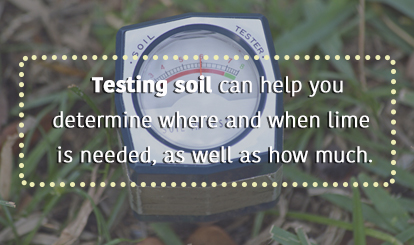
Here are the top
benefits of using agricultural lime for crops:
·
Reduces Levels of
Manganese and Iron
By applying
agricultural lime to crops, you can help to increase the soil’s pH level by
neutralizing and reducing the levels of manganese and iron that cause soil to
become acidic. Lower manganese and iron levels can help to reduce the risk of
plants becoming toxic, which helps increase their growth and output rates.
·
Boosts Microbial
Activity
When soil is too
acidic, the beneficial microbes in the soil aren’t able to thrive. This reduces
soil health and the possibility of nutrient uptake in the crop’s roots. The
agricultural lime effect on crops allows it to create a better environment to
promote microbial activity to improve healthy crop growth.
·
Improves Plant Structure
With a balanced pH
level in the soil, the crop, especially young plants, can grow stronger
overall. This additional strength starts in the roots and works its way up
through the complete plant structure. Improved plant structure ensures the
crops are healthier and able to yield more.
·
Provides Calcium
and Magnesium
Agricultural lime
actively supplements calcium and/or magnesium levels in the soil. These are
essential nutrients to ensuring healthy plant growth. Agricultural lime
provides a steady supply of the nutrients, which over time ensures the soil is
conditioned appropriately for optimum output.
·
Provides a Return
on Investment
When it comes to
financial benefits, agricultural lime for crops is worth the investment.
Agricultural lime is a long-term solution for ensuring maximum crop output. A
single application of agricultural lime can last up to several years. During
these years, your crops will produce better yields, which translates to more
product and/or better product to sell.
·
Increases Nutrient
Uptake in Roots
Once the DR. GREEN
for crops is applied, it will begin to balance out the soil’s pH levels. A
neutral or neutralized soil provides a healthy environment for plants to
improve their nutrient uptake. When grown in acidic soil, plants struggle to
take up nutrients. Once the soil becomes less acidic, the roots look for more
nutrients to absorb.
·
Strengthens Root
System
As roots take up a
greater volume of nutrients, they begin to thrive and strengthen throughout the
whole root system. Having a strong root system in your crops is essential for
the crop’s ability to withstand environmental challenges such as rain, wind or
drought.
·
Improves Nitrogen
Fixation in Legumes
For legume crops
like soybeans, agricultural lime can help improve nitrogen fixation. This is
the process by which bacteria that live within the legume roots are able to
convert atmospheric nitrogen into nutrients which crops can use.
·
Improves
Fertilizer/Herbicide Efficiency
When the soil
becomes too acidic, it prevents herbicides from functioning properly. Acidic
soil can also decrease fertilizer efficiency. By restoring soil to a more
neutral pH level, it can help improve the efficiency of fertilizers and
herbicides, which further improves your bottom line.
·
Reduces Toxicity
Levels
Ultimately,
applying lime to agricultural crops will eliminate the state of toxicity that
the plants are experiencing. Acidic soil is toxic for plants. Over time, acidic
soil will kill crops. By neutralizing soil acidity while simultaneously
providing adequate nutrition, you can move your crops from a toxic state to a
thriving state.
Investing in Future Crop Production
While agricultural
lime may seem at times like an expensive initial investment, the cost of the
potential yield loss due to acidic soil conditions is far more costly than
applying agricultural lime. Over time, agricultural lime can drastically
improve soil conditions, leading to greater yields and greater profits.
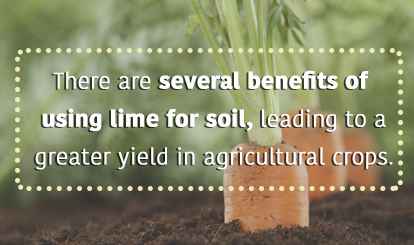
Agricultural lime
is a valuable investment that will see a return over time. It is important to
get in the habit of applying lime to crops as needed in order to keep the pH
levels stabilized. Otherwise, not having lime applied to crops when needed can
perpetuate acidic conditions and reduce crop output. Agricultural lime should
be an important consideration in any nutrient management plan.
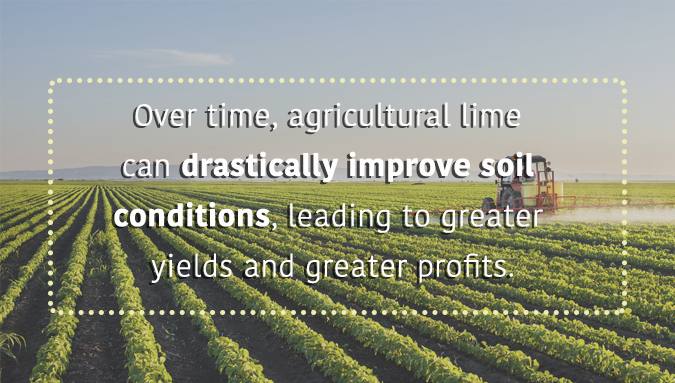
If your soil is
currently facing high levels of acidity, it’s important to invest in
agricultural lime application today.


